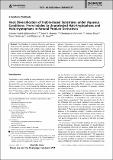Files in this item
Heck diversification of indole‐based substrates under aqueous conditions : from indoles to unprotected halo‐tryptophans and halo‐tryptophans in natural product derivatives
Item metadata
| dc.contributor.author | Pubill-Ulldemolins, Cristina | |
| dc.contributor.author | Sharma, Sunil V. | |
| dc.contributor.author | Cartmell, Chris | |
| dc.contributor.author | Zhao, Jinlian | |
| dc.contributor.author | Cárdenas, Paco | |
| dc.contributor.author | Goss, Rebecca J. M. | |
| dc.date.accessioned | 2019-07-19T15:30:02Z | |
| dc.date.available | 2019-07-19T15:30:02Z | |
| dc.date.issued | 2019-08-14 | |
| dc.identifier | 259064662 | |
| dc.identifier | 6d1fe335-17e5-4494-8ff6-a88cc7a4faf0 | |
| dc.identifier | 85069893063 | |
| dc.identifier | 000481420300015 | |
| dc.identifier.citation | Pubill-Ulldemolins , C , Sharma , S V , Cartmell , C , Zhao , J , Cárdenas , P & Goss , R J M 2019 , ' Heck diversification of indole‐based substrates under aqueous conditions : from indoles to unprotected halo‐tryptophans and halo‐tryptophans in natural product derivatives ' , Chemistry - A European Journal , vol. 25 , no. 46 , pp. 10866-10875 . https://doi.org/10.1002/chem.201901327 | en |
| dc.identifier.issn | 0947-6539 | |
| dc.identifier.uri | https://hdl.handle.net/10023/18137 | |
| dc.description | The research leading to these results has received funding from the European Research Council under the European Union’s Seventh Framework Programme (FP7/2007-2013/ERC grant agreement no 614779 GenoChemetics (to R.J.M.G). P. C. is supported by the European Union's Horizon 2020 research and innovation program through the SponGES project (grant agreement No. 679849). C.P-U. was supported by the Marie Sklodowska-Curie Fellowship C-XAq. | en |
| dc.description.abstract | The blending of synthetic chemistry with biosynthetic processes provides a powerful approach to synthesis. Biosynthetic halogenation and synthetic cross‐coupling have great potential to be used together, for small molecule generation, access to natural product analogues and as a tool for chemical biology. However, to enable enhanced generality of this approach, further synthetic tools are needed. Though considerable research has been invested in the diversification of phenylalanine and tyrosine, functionalisation of tryptophans thorough cross‐coupling has been largely neglected. Tryptophan is a key residue in many biologically active natural products and peptides; in proteins it is key to fluorescence and dominates protein folding. To this end, we have explored the Heck cross‐coupling of halo‐indoles and halo‐tryptophans in water, showing broad reaction scope. We have demonstrated the ability to use this methodology in the functionalisation of a brominated antibiotic (bromo‐pacidamycin), as well as a marine sponge metabolite, barettin. | |
| dc.format.extent | 11 | |
| dc.format.extent | 995234 | |
| dc.language.iso | eng | |
| dc.relation.ispartof | Chemistry - A European Journal | en |
| dc.subject | Aqueous cross coupling | en |
| dc.subject | Barettin | en |
| dc.subject | Heck reaction | en |
| dc.subject | Natural product modification | en |
| dc.subject | Halo-tryptophan | en |
| dc.subject | QD Chemistry | en |
| dc.subject | NDAS | en |
| dc.subject | SDG 14 - Life Below Water | en |
| dc.subject.lcc | QD | en |
| dc.title | Heck diversification of indole‐based substrates under aqueous conditions : from indoles to unprotected halo‐tryptophans and halo‐tryptophans in natural product derivatives | en |
| dc.type | Journal article | en |
| dc.contributor.sponsor | European Research Council | en |
| dc.contributor.sponsor | European Commission | en |
| dc.contributor.institution | University of St Andrews. School of Chemistry | en |
| dc.contributor.institution | University of St Andrews. Biomedical Sciences Research Complex | en |
| dc.contributor.institution | University of St Andrews. EaSTCHEM | en |
| dc.identifier.doi | 10.1002/chem.201901327 | |
| dc.description.status | Peer reviewed | en |
| dc.identifier.grantnumber | GCGXC | en |
| dc.identifier.grantnumber | 659399 | en |
This item appears in the following Collection(s)
Items in the St Andrews Research Repository are protected by copyright, with all rights reserved, unless otherwise indicated.

